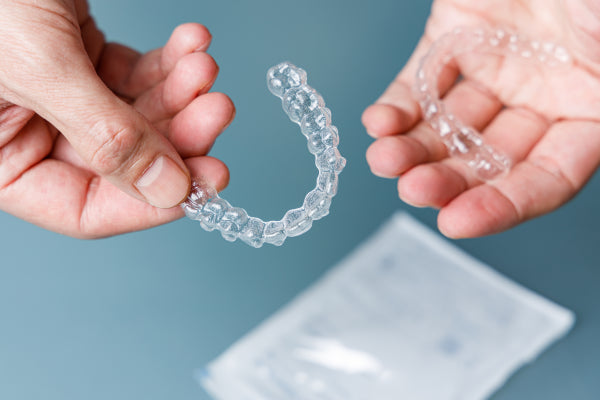
Table of Contents
- Why Teeth Straightening Matters (More than You Think)
- Understanding the Options: Aligners vs Braces vs Retainers
- Side-by-Side Comparison: Aligners vs. Braces vs. Retainers
- Why Clear Aligners Are Leading the Future
- Braces and Retainers Still Have a Place
- What Does the Future of Orthodontics Look Like?
- Which One Is Right for You?
- FAQs
It’s hard to believe how far orthodontics has come. Not too long ago, straightening your teeth meant wearing bulky metal braces that seemed to take forever, and came with more than their fair share of discomfort. But fast-forward to today, and you’ve got sleek, nearly invisible aligners, personalized treatment plans, and even virtual check-ins.
From braces to clear aligners, orthodontic trends and beyond are making smiles better. In this blog, we’ll look at the three main players in the world of teeth straightening: clear aligners, braces, and retainers. We’ll also explore what each one offers, how they compare, and what the future of teeth straightening looks like for anyone thinking about improving their smile.
Why Teeth Straightening Matters (More than You Think)
Straightening your teeth isn’t just about looking better in photos, though that’s a plus. It’s about making everyday life easier and healthier. Crooked teeth or bite issues can cause all sorts of practical problems : trouble chewing, jaw pain, speech difficulties, and even more frequent cavities because crowded teeth are harder to clean.
Let’s say you have a slight overbite that you’ve always ignored. You might not think much of it, but over time, it could lead to uneven tooth wear or stress on your jaw joint. That’s why orthodontic treatment, whether through aligners or braces, isn’t just cosmetic. It’s a long-term investment in your oral health.
Confidence plays a big role, too. We’ve seen it time and time again, people who finish their aligner treatment with ALIGNERCO often say it’s not just their smile that’s changed. It’s the way they speak up in meetings, pose for pictures, or walk into a room. When your smile reflects how you feel on the inside, it’s empowering.
So yes, teeth straightening matters. Luckily, with modern orthodontic treatments, we’ve never had more flexible, accessible options than we do today.
Understanding the Options: Aligners vs Braces vs Retainers
When it comes to straightening your teeth, most people think of braces first for good reason. But they’re no longer the only option. Here’s a quick breakdown of how braces, aligners, and retainers each play a role in modern orthodontic care.

Clear Aligners: The Modern Favorite
Clear aligners like those from ALIGNERCO have changed the game for orthodontic care. These are custom-made, transparent trays that fit over your teeth and gently shift them with consistent pressure. They’re worn for 20–22 hours a day and swapped out every 1–2 weeks for a new set that continues the movement.
Who they’re for: People with mild to moderate alignment issues who prefer a discreet, flexible option.
Pros:
- Nearly invisible and removable
- No food restrictions
- Comfortable and easy to clean
- Remote treatment options available (like ALIGNERCO)
Cons:
- Requires discipline to wear as instructed
- May not be suitable for very complex cases

Braces: The Traditional Route
Braces have been around for decades and are still widely used today, especially for more complex dental issues. They consist of metal brackets that are bonded to your teeth and connected by wires, which your orthodontist tightens over time to guide your teeth into place.
Who they’re for: People with severe crowding, bite issues, or jaw alignment problems.
Pros:
- Effective for even the most complicated cases
- Fully supervised by an orthodontist
- Reliable results over time
Cons:
- Highly visible
- Can be uncomfortable, especially after adjustments
- Food restrictions and more difficult cleaning

Retainers: The Long-Term Maintenance
Retainers aren’t used to straighten teeth initially, they’re used to keep them straight after braces or aligners. After active treatment, your teeth can slowly shift back to their old positions. Retainers make sure your results last.
Types:
- Removable (clear plastic or Hawley retainers)
- Fixed (bonded behind the teeth, often on the lower front teeth)
Why they matter: Without retainers, even the best orthodontic work can be undone over time. They're your insurance policy for that newly straightened smile.
So when people ask, "Which is better, aligners or retainers?" or "Is it better to get braces or retainers?", the answer really comes down to your situation. You'll need braces or aligners if you’re just starting your orthodontic treatment. If you’ve already completed treatment, a retainer is what helps you preserve that progress for life.
Understanding the roles of each can help you avoid confusion and make smarter decisions about your smile. It’s not a matter of aligners vs braces vs retainers, it’s more about where you are in your orthodontic journey. Braces and aligners are for correcting issues. Retainers are for keeping those results in place.
Side-by-Side Comparison: Aligners vs. Braces vs. Retainers
Let’s break it down. Here's a straightforward look at how aligners, braces, and retainers stack up across different categories:
| Feature | Clear Aligners (ALIGNERCO) | Braces | Retainers |
|---|---|---|---|
| Purpose | Active treatment | Active treatment | Post-treatment maintenance |
| Visibility | Nearly invisible | Highly visible (metal) | Mostly invisible (depends on type) |
| Comfort | Smooth plastic, removable | Metal brackets and wires | Varies – usually comfortable |
| Wear Time | 20–22 hours/day | 24/7, until removed by an orthodontist | Varies (often at night) |
| Convenience | Removable, no food restrictions | Fixed, dietary restrictions | Removable or fixed |
| Best For | Mild to moderate misalignment | Severe or complex cases | Maintaining teeth position |
| Treatment Time | 4–8 months (on average) | 12–24 months (varies) | Ongoing after treatment |
| Professional Supervision | Remote check-ins (licensed orthodontist) | Regular in-person visits | Post-treatment monitoring |
| Cost Range | $$ – Affordable options like ALIGNERCO | $$$ – Often higher cost | $ – Typically included after treatment |
Each has its role. Aligners are a modern, flexible option for many patients. Braces are still the go-to for complex issues. And retainers? They're the long-term key to keeping your smile in place.
Why Clear Aligners Are Leading the Future
Modern orthodontic treatments are evolving, and clear aligners are quickly becoming the go-to choice for people looking for flexibility, aesthetics, and convenience. More patients today want options that fit into their lifestyle, not the other way around. That’s where aligners are really stepping ahead of the curve.
A Shift Toward Remote and Lifestyle-Friendly Solutions
The demand for remote care has skyrocketed, especially among adults and teens who value independence. With aligners, you don’t need to rearrange your life around monthly clinic visits. Platforms like ALIGNERCO make it possible to straighten your teeth from the comfort of home, no waiting rooms, no hassle. Thanks to ongoing teeth alignment innovations, these at-home solutions are now more precise, efficient, and accessible than ever before.

ALIGNERCO’s Approach to Modern Orthodontic Treatments
At ALIGNERCO, we believe that the best teeth straightening method should be both effective and accessible. That’s why we’ve built a system that includes:
- Affordable pricing, starting at just $795
- Dentist-approved 3D treatment plans before you commit
- An easy-to-use at-home impression kit
- Ongoing remote support throughout your journey
Tech That Works for You
We’re also embracing the future of orthodontics by integrating smart technology into your experience. From 3D treatment plans that let you preview your future smile to dedicated customer support that’s just a click away, ALIGNERCO puts control back in your hands.
A Growing Favorite Among Adults and Teens
It’s not just about appearance, though, aligners are virtually invisible. It’s about feeling empowered to choose a solution that works with your schedule, your goals, and your budget. That’s why aligners are becoming one of the most popular and modern orthodontic treatments available today.
Clear aligners aren't just a trend, they’re a reflection of where orthodontics is headed. And with ALIGNERCO leading the way, that future is looking bright.
Braces and Retainers Still Have a Place
While clear aligners are leading the way in modern orthodontics, it doesn’t mean that braces and retainers are outdated. In fact, each tool continues to serve an important role depending on the needs of the patient.
Braces: Still the Best for Complex Cases
For patients with more complicated dental issues, like severely rotated teeth, major bite misalignments, or significant crowding, braces remain the most effective solution . The fixed nature of braces allows orthodontists to apply precise force and make detailed adjustments over time.
They’re particularly valuable in cases where jaw structure also needs correction, something aligners may not always be able to address alone. Braces offer full control in such scenarios, which is why they continue to be a trusted treatment option.
Retainers: Essential for Long-Term Results
Retainers may not get as much attention as braces or aligners, but they’re arguably the most important part of any orthodontic journey. After your teeth have been moved into their new positions, retainers hold them there and prevent them from slowly shifting back.
Most orthodontists recommend wearing retainers nightly, even years after active treatment ends, to keep that hard-earned smile in place. Whether removable or fixed, retainers are your smile’s long-term insurance.
The Right Tool for the Right Stage
It’s not a question of braces vs. aligners vs. retainers, orthodontists often use these tools together throughout a patient’s treatment. You might start with braces or aligners, and then transition to a retainer once your active treatment is complete.
Ultimately, the best orthodontic care isn’t about choosing one tool over the other, it’s about using the right tool at the right time to get the best results.

What Does the Future of Orthodontics Look Like?
Orthodontics is on the brink of even more exciting changes, and the future looks smarter, simpler, and more sustainable. With evolving dental technology reshaping how we diagnose, plan, and treat, here’s what’s on the horizon:
AI-Driven Treatment Planning
Artificial intelligence is already transforming treatment precision. With AI tools, orthodontists can now analyze bite patterns, predict tooth movement, and design highly accurate treatment plans faster than ever. That means better outcomes with fewer refinements and delays.
At-Home 3D Scanning and App Integration
Gone are the days when you had to sit in a dentist’s chair for impressions. Modern tools are making it possible to capture 3D scans at home using specialized kits and even mobile-connected devices. As more apps integrate treatment progress tracking, reminders, and virtual support, managing your orthodontic journey will feel more like managing your fitness goals, simple and user-friendly.
Greater Global Access through Brands like ALIGNERCO
Not everyone lives near an orthodontist or can afford traditional in-office visits. That’s why companies like ALIGNERCO are leading the way in bringing modern orthodontic treatments to people across the globe. With mail-in impression kits, expert-reviewed treatment plans, and virtual check-ins, high-quality care is becoming more accessible regardless of where you live.
Eco-Friendly Aligner Materials and Production
Sustainability is taking center stage in healthcare, too. The next generation of aligners is being designed with recyclable or bio-based materials to reduce environmental impact. Meanwhile, digital workflows are minimizing waste by eliminating unnecessary office visits, paper records, and packaging.
These changes aren’t just nice-to-have; they also help debunk common myths about aligners , such as assumptions about their environmental footprint. They’re signs that the orthodontic industry is adapting to a more tech-savvy, environmentally conscious, and patient-driven world. And with ALIGNERCO staying ahead of the curve, the future of teeth straightening looks more promising and more personalized than ever.
Which One Is Right for You?
With so many teeth straightening options available, it’s normal to wonder which one suits you best. The truth is, the right choice depends on a few key factors: your specific dental needs, your lifestyle, and your budget.
If your case is more complex, say, involving rotated teeth or significant bite issues, traditional braces might be a better option. They offer the kind of detailed, hands-on adjustments that more complicated cases require.
For mild to moderate alignment issues, clear aligners are often the most convenient solution. They’re discreet, removable, and lifestyle-friendly, ideal for adults or teens who want results without the visibility and restrictions of braces.
And remember, after treatment with either braces or aligners, retainers are essential to maintain your results. They help protect the investment you’ve made in your smile.
FAQs
1. Are aligners faster than braces?
To answer simply, yes. Aligner treatment can be faster, but it depends on multiple factors, some of which are patient compliance, severity of misalignment, and quality of aligners used.
2. Do I still need a retainer after aligner treatment?
Do I still need a retainer after aligner treatment?
3. Can aligners fix severe misalignment?
Clear aligners are best suited for mild/moderate misalignment. You can check your eligibility by taking a free assessment.
Citations:
Professional, C. C. M. (2024, May 1). Clear braces. Cleveland Clinic. https://my.clevelandclinic.org/health/treatments/23568-clear-braces
(https://www3.aaoinfo.org/wp-content/uploads/2018/07/Adult_Orthodontics15-cons-hl-1.pdf). Accessed 1/13/2023.
American Dental Association. Braces (https://www.mouthhealthy.org/all-topics-a-z/braces). Accessed 1/13/2023.
Lin E, Julien K, Kesterke M, Buschang PH. Differences in finished case quality between Invisalign and traditional fixed appliances (https://pubmed.ncbi.nlm.nih.gov/35168256/). Angle Orthod. 2022 Mar 1;92(2):173-179. Accessed 1/13/2023.






